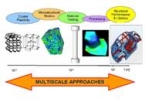Abstract
The purpose of the project consists in the development material models at microscopic scale and their transfer to macroscopic scale by implementation in computer programmes for the simulation of sheet metal forming processes. In order to achieve this purpose, four objectives have been defined.
The first objective consists in the experimental characterization of the materials selected for testing at micro- and macro-level. By achieving this objective, a database referring to the plastic behaviour of the tested materials will be created.
The second objective consists in the development of plasticity models at micro- and macro-level. By achieving this objective, the members of the consortium will have a set of realistic and robust plasticity models able to describe the anisotropic behaviour of materials.
The third objective consists in the implementation of the previously developed models in computer programmes for the simulation of the sheet metal forming processes. By achieving this objective, the consortium will have a set of robust and efficient computer programmes for the numerical simulation of hydraulic bulging, deep-drawing of cylindrical parts and prediction of the forming limit curves.
The last objective of the project consists in the experimental validation the simulation programmes previously elaborated. By achieving this objective, a set of simulation programmes having a high accuracy will be available for the use in industrial applications with the aim of obtaining a realistic and robust virtual prototype.
The achievement of the general purpose needs the cooperation between experts from interdisciplinary domains and having a rich expertise in modelling, numerical methods, experimental procedures, with a comprehensive understanding of the phenomena that occur at micro- and macroscopic scale. With this aim in view, an interdisciplinary and complementary consortium as concerns the scientific background and the laboratory equipment has been established.
